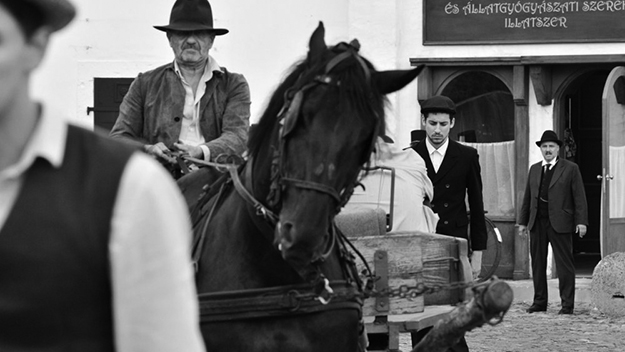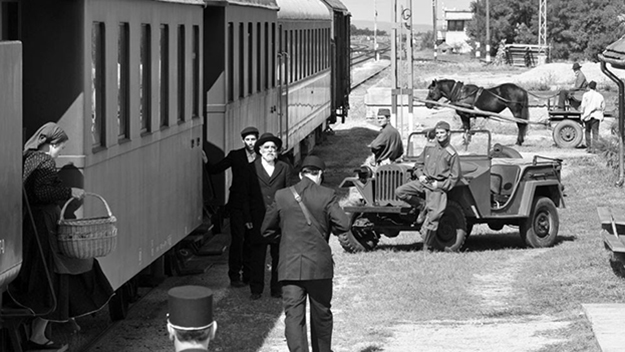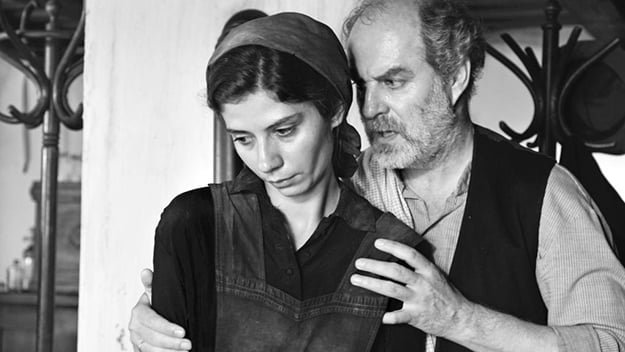1945 takes place one year after the Jews in a small Hungarian village were deported to concentration camps. The movie begins early on August 12. The town clerk/de facto mayor (Péter Rudolf) lathers and shaves as the Soviet-controlled radio reports on the Nagasaki A-bomb and the Sino-Soviet War. He’s set to marry off his beanpole son to a strong, comely young woman, who will help the lad run a pharmacy previously owned by a deportee. Nothing works out as planned. For on the fringes of this sleepy hamlet, the morning train soon steams into view, carrying two black-clad Orthodox Jews—a white-bearded elder in a knee-length overcoat and round, broad-brimmed hat, and his stubbled son in a too-tight suit and poor-boy’s cap. Another father and son, Gentile peasants, have been hired to haul trunks labeled “perfume” from the station through the town, as the Jews solemnly march behind the wagon. Their unheralded arrival ignites anxiety in the clerk and his countrymen. All a peasant has to say to rouse some panic is: “They’re back.” But who’s back? Are the two Jews from this area or are they delegates of uprooted or martyred families, intent on recovering their property? No one recognizes their names or faces—then again, most residents see Orthodox Jews as nothing more than hats and beards. Ignorance, guilt, and paranoia fuel the inherent suspense of 1945. With its canny use of evocative visual tropes like weathered men waiting at a rickety depot in a parched, flat landscape, the film has been compared to Westerns like High Noon, 3:10 to Yuma, and Once Upon a Time in the West. But it’s even closer to thrillers that reveal the tainted hearts of ingrown or claustrophobic neighborhoods, like Le Corbeau, Panique, and (especially) Bad Day at Black Rock. Sadly and sardonically, its view of Jews as aliens unhinging a self-enclosed society (“they’re back”) reminds me of Rod Serling’s Twilight Zone episode “The Monsters Are Due on Maple Street.” But 1945 doesn’t rely on a showdown or vendetta, a poison-pen campaign, or a town conspiring on murder and a cover-up. These rural Magyars committed most of their crimes out in the open, during the Nazi occupation in 1944. From various combinations of weakness, terror, prejudice, and greed, they acquiesced in the Holocaust.
The director and co-writer, Ferenc Török, and his cinematographer, Elemér Ragályi, shot the film in a black and white that feels baked into the images. The look conjures a tinderbox atmosphere that turns cathartic when one key setting actually does burst into flames. Morally, the characters tend toward pitch-black or charcoal gray. Almost everyone has collaborated in appropriating the land, homes, furnishings, bicycles, and sewing machines forcibly abandoned by the Jews. One honorable woman has lived up to her agreement to store a Jewish family’s goods in case they return after the war. Another confesses her anguish over giving away, under duress, a young Jew’s hiding place. The town clerk has outdone everyone else in avarice. He betrayed his ostensible best friend, the pharmacist, then swooped down on his business. His appalled wife takes morphine to dull her sensitivity to this ethical breakdown. Rudolf’s performance as the clerk demands attention. Like Bob Hoskins in his prime, he sucks us into the sweaty machinations of a limited man whose amoral ambition long ago clicked into overdrive. Based on “Homecoming,” a sturdy short story by Gábor T. Szántó (who co-wrote the script), 1945 never devolves into hysteria or melodrama. It gathers inexorable force by moving at the same steady pace as the father and son. The townspeople grow ever more anxious and befuddled as the Jews stop in town without revealing the true reason for their visit. The purposeful gait and steady look of these men in black tell the villagers that this father and son do have a purpose. In the film’s shattering revelation, we learn that their journey has nothing to do with regaining property or exacting retribution. It has everything to do with honoring their dead. Once the Jews achieve their goal, they turn away and move on.
John Huston’s strategy of depicting the gold-hungry men in The Treasure of the Sierra Madre was to keep the camera “impersonal, it just looks on and lets them stew in their own juice.” Török adopts his own version of this hyper-observant attitude. It enables us to read the power relationships as well as the emotional flowchart of an entire population. The director captures every spark of friction between peasants and bourgeoisie or war veterans and men who stayed behind. He achieves a style at once spare and enveloping, psychologically and socially. We feel the psychic liberation of the town clerk’s son as he turns his back on the future his dad plotted out for him. We experience the casual arrogance of the Soviets as a grunt makes a feeble grab for the young Jew’s cap or a jeep-full of soldiers hound a pretty runaway bride. Yet the film doesn’t fall into anachronistic anti-Communism: one muscle-bound swain sees the Hungarian Communist Party as his country’s best chance for social equality. The movie’s denouement is indelible. A thunderstorm blusters into the hot summer day. The two Jews, drenched and weary, return to the depot, where the town clerk’s son waits, too. After they all board another old steam train, we see it blowing smoke and spume against the driving rain. Not even an August downpour can disperse these black, man-made clouds. Just as no cleansing ritual can wash away the Holocaust’s human stain. Michael Sragow is a contributing editor to Film Comment and writes its Deep Focus column. He is a member of the National Society of Film Critics and the Los Angeles Film Critics Association. He also curates “The Moviegoer” at the Library of America website.


